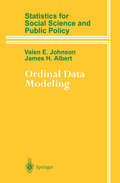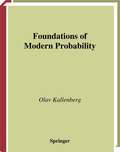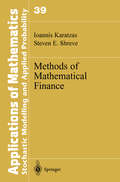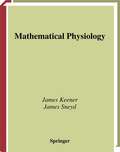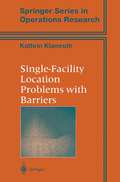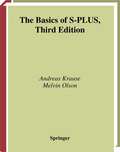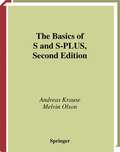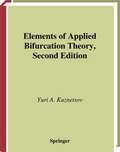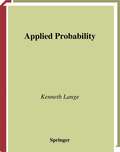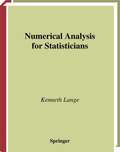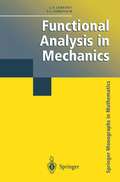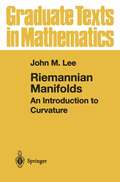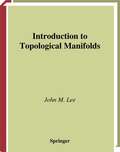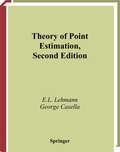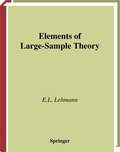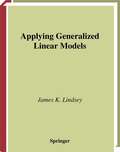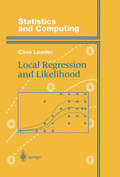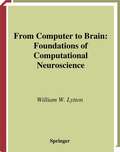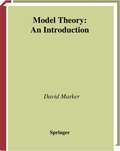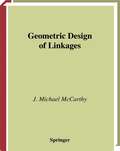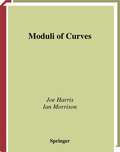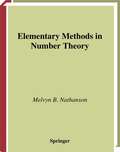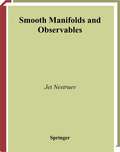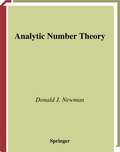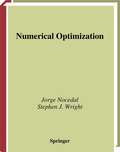- Table View
- List View
Ordinal Data Modeling (Statistics for Social and Behavioral Sciences)
by Valen E. Johnson James H. AlbertOrdinal Data Modeling is a comprehensive treatment of ordinal data models from both likelihood and Bayesian perspectives. A unique feature of this text is its emphasis on applications. All models developed in the book are motivated by real datasets, and considerable attention is devoted to the description of diagnostic plots and residual analyses. Software and datasets used for all analyses described in the text are available on websites listed in the preface.
Foundations of Modern Probability (Probability and Its Applications)
by Olav KallenbergUnique for its broad and yet comprehensive coverage of modern probability theory, ranging from first principles and standard textbook material to more advanced topics. In spite of the economical exposition, careful proofs are provided for all main results. After a detailed discussion of classical limit theorems, martingales, Markov chains, random walks, and stationary processes, the author moves on to a modern treatment of Brownian motion, L=82vy processes, weak convergence, It=93 calculus, Feller processes, and SDEs. The more advanced parts include material on local time, excursions, and additive functionals, diffusion processes, PDEs and potential theory, predictable processes, and general semimartingales.Though primarily intended as a general reference for researchers and graduate students in probability theory and related areas of analysis, the book is also suitable as a text for graduate and seminar courses on all levels, from elementary to advanced. Numerous easy to more challenging exercises are provided, especially for the early chapters.From the author of "Random Measures".
Methods of Mathematical Finance (Stochastic Modelling And Applied Probability Ser. #39)
by Ioannis Karatzas Steven ShreveThis sequel to Brownian Motion and Stochastic Calculus by the same authors develops contingent claim pricing and optimal consumption/investment in both complete and incomplete markets, within the context of Brownian-motion-driven asset prices. The latter topic is extended to a study of equilibrium, providing conditions for existence and uniqueness of market prices which support trading by several heterogeneous agents. Although much of the incomplete-market material is available in research papers, these topics are treated for the first time in a unified manner. The book contains an extensive set of references and notes describing the field, including topics not treated in the book. This book will be of interest to researchers wishing to see advanced mathematics applied to finance. The material on optimal consumption and investment, leading to equilibrium, is addressed to the theoretical finance community. The chapters on contingent claim valuation present techniques of practical importance, especially for pricing exotic options.
Mathematical Physiology (Interdisciplinary Applied Mathematics #8)
by James Keener James SneydDivided into two parts, the book begins with a pedagogical presentation of some of the basic theory, with chapters on biochemical reactions, diffusion, excitability, wave propagation and cellular homeostasis. The second, more extensive part discusses particular physiological systems, with chapters on calcium dynamics, bursting oscillations and secretion, cardiac cells, muscles, intercellular communication, the circulatory system, the immune system, wound healing, the respiratory system, the visual system, hormone physiology, renal physiology, digestion, the visual system and hearing.
Single-Facility Location Problems with Barriers (Springer Series in Operations Research and Financial Engineering)
by Kathrin KlamrothThis text develops the mathematical implications of barriers to the geometrical and analytical characteristics of continuous location problems. The book will appeal to those working in operations research and management science, and mathematicians interested in optimization theory and its applications.
The Basics of S-PLUS (Statistics and Computing)
by Andreas Krause Melvin OlsonIn a clear style the most important ideas of S-PLUS are introduced through the use of many examples. Each chapter includes a collection of exercises, fully worked-out solutions and detailed comments.
The Basics of S and S-PLUS (Statistics and Computing)
by Andreas Krause Melvin OlsonA lucid explanation of the basics of S-PLUS at a level suitable for users with little computing or statistical knowledge. Unlike the S-PLUS manuals, the book does not strive to be comprehensive, but instead introduces the most important ideas of S-PLUS through the use of many examples. Each chapter includes a collection of exercises that are accompanied by fully worked-out solutions and detailed comments, and the whole is rounded off with practical hints on how to work efficiently in S-PLUS, making it well-suited for both self-study and as a textbook. This second edition has been updated to incorporate the completely revised S Language and its implementation in S-PLUS, while new chapters have been added to explain the Windows GUI, how to explore relationships in data using the powerful Trellis graphics system, and how to understand and use object-oriented programming. In addition, the programming chapter has been extended to cover some of the more technical but important aspects of S-PLUS.
Elements of Applied Bifurcation Theory (Applied Mathematical Sciences #112)
by Yuri KuznetsovProviding readers with a solid basis in dynamical systems theory, as well as explicit procedures for application of general mathematical results to particular problems, the focus here is on efficient numerical implementations of the developed techniques. The book is designed for advanced undergraduates or graduates in applied mathematics, as well as for Ph.D. students and researchers in physics, biology, engineering, and economics who use dynamical systems as model tools in their studies. A moderate mathematical background is assumed, and, whenever possible, only elementary mathematical tools are used. This new edition preserves the structure of the first while updating the context to incorporate recent theoretical developments, in particular new and improved numerical methods for bifurcation analysis.
Applied Probability (Springer Texts in Statistics)
by Kenneth LangeDespite the fears of university mathematics departments, mathematics educat,ion is growing rather than declining. But the truth of the matter is that the increases are occurring outside departments of mathematics. Engineers, computer scientists, physicists, chemists, economists, statis- cians, biologists, and even philosophers teach and learn a great deal of mathematics. The teaching is not always terribly rigorous, but it tends to be better motivated and better adapted to the needs of students. In my own experience teaching students of biostatistics and mathematical bi- ogy, I attempt to convey both the beauty and utility of probability. This is a tall order, partially because probability theory has its own vocabulary and habits of thought. The axiomatic presentation of advanced probability typically proceeds via measure theory. This approach has the advantage of rigor, but it inwitably misses most of the interesting applications, and many applied scientists rebel against the onslaught of technicalities. In the current book, I endeavor to achieve a balance between theory and app- cations in a rather short compass. While the combination of brevity apd balance sacrifices many of the proofs of a rigorous course, it is still cons- tent with supplying students with many of the relevant theoretical tools. In my opinion, it better to present the mathematical facts without proof rather than omit them altogether.
Numerical Analysis for Statisticians (Statistics and Computing)
by Kenneth LangeNumerical analysis is the study of computation and its accuracy, stability and often its implementation on a computer. This book focuses on the principles of numerical analysis and is intended to equip those readers who use statistics to craft their own software and to understand the advantages and disadvantages of different numerical methods.
Functional Analysis in Mechanics: Applications In Mechanics And Inverse Problems (Springer Monographs in Mathematics #100)
by Leonid P. Lebedev I. I. VorovichRiemannian Manifolds: An Introduction to Curvature (Graduate Texts in Mathematics #176)
by John M. LeeThis text focuses on developing an intimate acquaintance with the geometric meaning of curvature and thereby introduces and demonstrates all the main technical tools needed for a more advanced course on Riemannian manifolds. It covers proving the four most fundamental theorems relating curvature and topology: the Gauss-Bonnet Theorem, the Cartan-Hadamard Theorem, Bonnet’s Theorem, and a special case of the Cartan-Ambrose-Hicks Theorem.
Introduction to Topological Manifolds (Graduate Texts in Mathematics #202)
by John M. LeeManifolds play an important role in topology, geometry, complex analysis, algebra, and classical mechanics. Learning manifolds differs from most other introductory mathematics in that the subject matter is often completely unfamiliar. This introduction guides readers by explaining the roles manifolds play in diverse branches of mathematics and physics. The book begins with the basics of general topology and gently moves to manifolds, the fundamental group, and covering spaces.
Theory of Point Estimation (Springer Texts in Statistics)
by Erich L. Lehmann George CasellaThis second, much enlarged edition by Lehmann and Casella of Lehmann's classic text on point estimation maintains the outlook and general style of the first edition. All of the topics are updated, while an entirely new chapter on Bayesian and hierarchical Bayesian approaches is provided, and there is much new material on simultaneous estimation. Each chapter concludes with a Notes section which contains suggestions for further study. This is a companion volume to the second edition of Lehmann's "Testing Statistical Hypotheses".
Elements of Large-Sample Theory (Springer Texts in Statistics)
by E.L. LehmannWritten by one of the main figures in twentieth century statistics, this book provides a unified treatment of first-order large-sample theory. It discusses a broad range of applications including introductions to density estimation, the bootstrap, and the asymptotics of survey methodology. The book is written at an elementary level making it accessible to most readers.
Applying Generalized Linear Models (Springer Texts in Statistics)
by James K. LindseyThis book describes how generalised linear modelling procedures can be used in many different fields, without becoming entangled in problems of statistical inference. The author shows the unity of many of the commonly used models and provides readers with a taste of many different areas, such as survival models, time series, and spatial analysis, and of their unity. As such, this book will appeal to applied statisticians and to scientists having a basic grounding in modern statistics. With many exercises at the end of each chapter, it will equally constitute an excellent text for teaching applied statistics students and non- statistics majors. The reader is assumed to have knowledge of basic statistical principles, whether from a Bayesian, frequentist, or direct likelihood point of view, being familiar at least with the analysis of the simpler normal linear models, regression and ANOVA.
Local Regression and Likelihood (Statistics and Computing)
by Clive LoaderSeparation of signal from noise is the most fundamental problem in data analysis, arising in such fields as: signal processing, econometrics, actuarial science, and geostatistics. This book introduces the local regression method in univariate and multivariate settings, with extensions to local likelihood and density estimation. Practical information is also included on how to implement these methods in the programs S-PLUS and LOCFIT.
From Computer to Brain: Foundations of Computational Neuroscience
by William W. LyttonBiology undergraduates, medical students and life-science graduate students often have limited mathematical skills. Similarly, physics, math and engineering students have little patience for the detailed facts that make up much of biological knowledge. Teaching computational neuroscience as an integrated discipline requires that both groups be brought forward onto common ground. This book does this by making ancillary material available in an appendix and providing basic explanations without becoming bogged down in unnecessary details. The book will be suitable for undergraduates and beginning graduate students taking a computational neuroscience course and also to anyone with an interest in the uses of the computer in modeling the nervous system.
Model Theory : An Introduction (Graduate Texts in Mathematics #217)
by David MarkerAssumes only a familiarity with algebra at the beginning graduate level; Stresses applications to algebra; Illustrates several of the ways Model Theory can be a useful tool in analyzing classical mathematical structures
Geometric Design of Linkages (Interdisciplinary Applied Mathematics #11)
by J. Michael McCarthyAn introduction to the mathematical theory of design for articulated mechanical systems known as linkages. This book will be useful to mathematics, engineering and computer science departments that teach courses on mathematical modelling of robotics and other articulated mechanical systems.
Moduli of Curves (Graduate Texts in Mathematics #187)
by Joe Harris Ian MorrisonA guide to a rich and fascinating subject: algebraic curves and how they vary in families. Providing a broad but compact overview of the field, this book is accessible to readers with a modest background in algebraic geometry. It develops many techniques, including Hilbert schemes, deformation theory, stable reduction, intersection theory, and geometric invariant theory, with the focus on examples and applications arising in the study of moduli of curves. From such foundations, the book goes on to show how moduli spaces of curves are constructed, illustrates typical applications with the proofs of the Brill-Noether and Gieseker-Petri theorems via limit linear series, and surveys the most important results about their geometry ranging from irreducibility and complete subvarieties to ample divisors and Kodaira dimension. With over 180 exercises and 70 figures, the book also provides a concise introduction to the main results and open problems about important topics which are not covered in detail.
Elementary Methods in Number Theory (Graduate Texts in Mathematics #195)
by Melvyn B. NathansonThis basic introduction to number theory is ideal for those with no previous knowledge of the subject. The main topics of divisibility, congruences, and the distribution of prime numbers are covered. Of particular interest is the inclusion of a proof for one of the most famous results in mathematics, the prime number theorem. With many examples and exercises, and only requiring knowledge of a little calculus and algebra, this book will suit individuals with imagination and interest in following a mathematical argument to its conclusion.
Smooth Manifolds and Observables (Graduate Texts in Mathematics #220)
by Jet NestruevThis book gives an introduction to fiber spaces and differential operators on smooth manifolds. Over the last 20 years, the authors developed an algebraic approach to the subject and they explain in this book why differential calculus on manifolds can be considered as an aspect of commutative algebra. This new approach is based on the fundamental notion of observable which is used by physicists and will further the understanding of the mathematics underlying quantum field theory.
Analytic Number Theory (Graduate Texts in Mathematics #177)
by Donald J. NewmanSome of the central topics in number theory, presnted in a simple and concise fashion. The author covers an amazing amount of material, despite a leisurely pace and emphasis on readability. His heartfelt enthusiasm enables readers to see what is magical about the subject. All the topics are presented in a refreshingly elegant and efficient manner with clever examples and interesting problems throughout. The text is suitable for a graduate course in analytic number theory.
Numerical Optimization (Springer Series in Operations Research and Financial Engineering)
by Jorge Nocedal Stephen WrightThe new edition of this book presents a comprehensive and up-to-date description of the most effective methods in continuous optimization. It responds to the growing interest in optimization in engineering, science, and business by focusing on methods best suited to practical problems. This edition has been thoroughly updated throughout. There are new chapters on nonlinear interior methods and derivative-free methods for optimization, both of which are widely used in practice and are the focus of much current research. Because of the emphasis on practical methods, as well as the extensive illustrations and exercises, the book is accessible to a wide audience.
